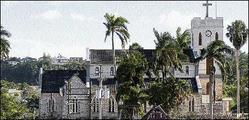
The historic St Mark's Anglican Church - Photo by Peter Kavanaugh
MANDEVILLE, Manchester:
Historical records seem to indicate that the parish of Manchester, and in particular the town of Mandeville, was created on December 13, 1814. Manchester was created as a result of representations made by residents of Mile Gully, May Day and Carpenters Mountain, who petitioned the local Assembly, headed by the then governor, the Duke of Manchester, for the establishment of a new parish with a town capital that would provide for their religious, civic and judicial needs.
Legacy
At that time, the petitioners pointed out that the nearest parochial and public buildings were 40 miles away (a considerable distance to walk or ride to pay taxes) and there was no church. The Duke wasted no time, and so, very much like the infamous Roman Emperor Nero, promulgated the necessary legislation as his intention was to leave a living and lasting legacy of his presence and that of his house and by extension the name of his favourite son, Viscount Mandeville, on the island.
And so, in very short order, a new parish was formed from sections or parts of St Elizabeth, Clarendon and Vere.
The parish capital, Mandeville was established in the early part of 1816 and by July 4, the vestry (parish council), comprising two elected churchwardens, 10 elected vestrymen, the custos, rector and magistrates, was established.
Justice
This body, the municipal authority, had the functions of administering justice in petty matters and taking care of the parish church.
On August 27, the vestry agreed on construction of a courthouse, a parsonage, a gaol or workhouse, and a church and by the very next year, 1817, secured 110 acres from Robert Crawford, Esquire, for the laying out of the town.
Not very long after the new town became one of the four hill stations for the army in Jamaica and a haven for English settlers who found it the closest place to home in Jamaica.
In its early years, Manchester's population was never as big as her neighbouring "parent parishes" primarily because sugar was not grown there.
However, the main route through the island from Kingston to Negril Point ran through south Manchester, and the general area was very popular because of its cool year-round climate, and relatively pristine beauty.
'Red gold'
One can perhaps safely assume that the Duke of Manchester, even in his wildest dream, could not have possibly foreseen that in 2008, nearly 194 years later, Mandeville and Manchester would have become the hub of central Jamaica because of discoveries such as 'red gold', that is bauxite, as well as other commercial developments, advances in science and technology and also agriculture.
See Part 2 of this feature in the Saturday Gleaner.

